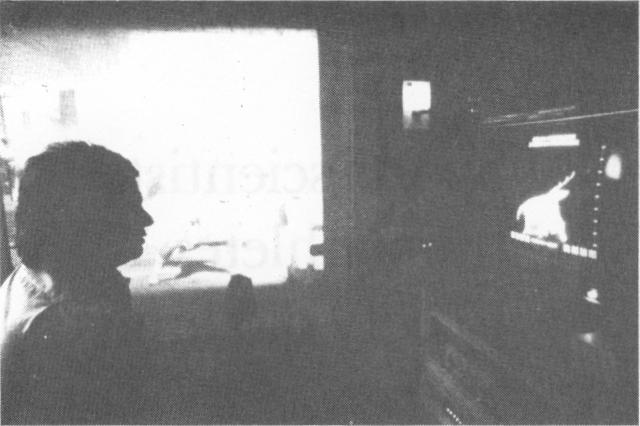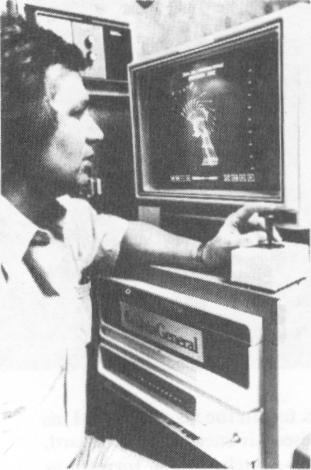| Previous | Index |
![]()
Using an electronic light pen, Dr. Gideon Ariel of the Computerized Biomechanical Analysis company reproduces the movements of the shot putter Al Fueurbach. Simultaneously, this reproduction appears in decomposed images on the television screen and the movements are analysed by the Nova computer which gives a "performance profile" of them. A similar application is used by the United States Olympic Committee on a Data General Eclipse S/250.
To give one example, after learning of Ariel's analyses, in 1975, the American discus thrower McWilkins gained 3.3 metres over his previous best throw, 69.7 m. instead of
Dr. Gideon Ariel, whom we see here in his Computerized Biomechanical Analysis laboratory at Amherst (Massachusetts), is the inventor of a logical system for the study and improvement of the performances of American athletes competing in the 1980 Olympic Games, both summer and winter. Dr. Ariel will use a Data General Eclipse S/250 installed by the United States Olympic Committee at Colorado Springs (Colorado).
66.2, the world record at the time being 68.5 m. He had noticed that his foot rubbed too heavily over the ground as he threw. It had taken only a little water to reduce the resistance to friction. "I had to rethink my whole way of throwing ; I had been in the habit of imparting maximum speed in the direction of the throw, whereas what was important was to concentrate on the deceleration as I let go." One year later in Montreal, McWilkins made a throw of 71.5 m. and won the gold medal. "A better designed shoe would have achieved the same result" added Ariel in passing. The case is similar for jogging ("the shoes of the future will be mounted on air cushions") or for tennis, where well-off players like Connors, who also attended Mr. Ariel's institute, can afford to have biomechanical shoes made to measure.
(The analysis of Connors's service showed that the fact of taking off from the ground at the moment he hit the ball robbed his first service of 15 to 20 km. per hour). "Most of the body's reverberations end in the feet and the proper absorption of shocks is the secret of improvement in long-distance races. Certain shoes absorb 2,300 newtons, others only 1,600, a difference manufacturers are not aware of."
Yet another example: the discus thrower Al Oerter, who won the gold medal at four consecutive Olympic Games and is greatly admired by Mr. Ariel. At 44 years of age, he continues to train, and his performance has dropped off by only about 20 %. After analysis by Dr. Ariel's system, it was noticed that the biological deterioration undergone by this extraordinary athlete, more than 10 years after his last victory, could be compensated for by a better approximation of his movements, in particular in his stance during the rotation preceding the throw. According to Mr. Ariel, correction of certain movements of his arm and the addition of lead to one of his shoes, led to a rapid improvement in his results, since he was said to have unofficially set a new world record.
Third example. In 1976, analysis carried out on the shot putter Terry Albritton showed that he bent the knee of the leg on which his weight rested instead of locking it. "It was just as if one were to try to fire cannon shots from a small boat", Ariel told him. Albritton took him at his word and one month later beat the world record, with a throw of 71.85 m.
The potential improvements that can be made by precise scientific analysis did not escape the notice of the coaches that Mr. Ariel met a few weeks ago in England, the Federal Republic of Germany, Sweden, France and Italy, to inform them that his company CBA was opening an experimental multisports centre at Cotto de Caza, in California. "There is no shame in admitting that we cannot see everything : we see the positions, the lines ; we do not see the amplitude or the magnitude. This means that biomechanical techniques can help us in the fields we cannot check for ourselves. For a coach that means learning to share," recently stated the American running coach O'Brien, known for his anti-conservative positions.
A research unit unique in the world for the wealth of its equipment and the methods of training used, the aim of the centre is to "bring biomechanical research within everyone's reach, not only top athletes who wish to obtain optimal performances, but also sports enthusiasts who wish to get to know themselves better, as well as the handicapped"
With biomechanical analysis, the coach of an Olympic team has the possibility of comparing his subjective impression with the objective analysis of the computer, and to take advantage of the invaluable assistance given, which enables him to detect more accurately the thresholds of fatigue and intensification of effort, for example. New progress, new programmes, new applications remain to be considered. Obviously, analysis on a digital screen would add much to the true scoring of sports that are judged subjectively like diving, gymnastics or figure skating. The object of the CBA's activity is in fact an anatomical and physiological study of a sportsman in movement, with a view to the concrete and individual transformation of his habits as an athlete, and the maximum use of the physical capital inherent in each of us.
"Up until 1964", concluded Mr. Ariel, talent alone was enough. Since then sport has passed from the domain of art into that of science."
Gideon Ariel : remarks
As a result of his analysis, Dr. Ariel has been able to make the following remarks
Rowing: "We can predict that oarsmen will soon be rowing in a two-step fashion: the first pair together, then the next pair, and so on, like the pistons of motor, continually in motion. It is considerably more efficient."
Kayak: "In the United States, athletes accelerate at the beginning of each paddle. They should accelerate at the end, like the Europeans. This would enable them to keep the curved end of the paddle in the water."
Jogging shoes: "Too many shocks. People will soon be running with inflatable shoes, whose pressure will be proportional to the weight of the wearer."
OLYMPIC REVIEW May 1980


![]()
| Previous | Index |